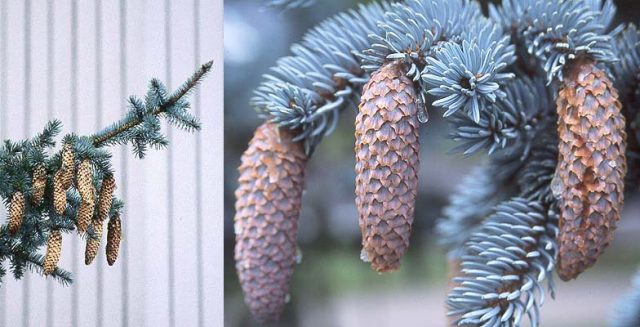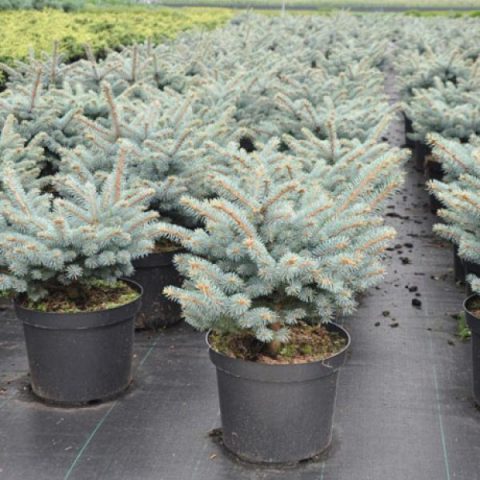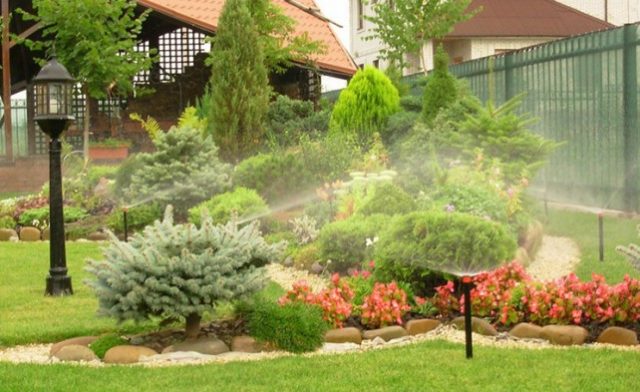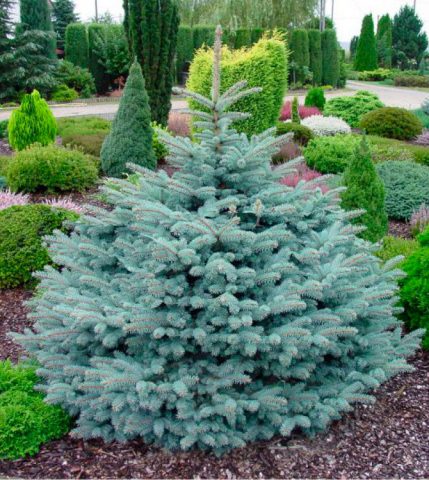Content
Prickly spruce (Picea pungens) is common in the mountains in the western United States of America, where it lives along the banks of streams and rivers. The color of needles in wild trees varies from dark green to blue or silver. So Blue Spruce or Glauca (Picea pungens Glauca) is not a specific name, but the designation of a group of varieties with a corresponding color of needles. They are widely used in culture and are considered the most beautiful of the conifers. Spruce Glauka Globoza is a popular dwarf variety that has become widespread due to its high decorative properties, slow growth and the possibility of seed propagation.
Description of spruce Glauka Globoza
The blue spruce variety Glauka Globoza was isolated by sowing seeds in 1937 in Boskop (Netherlands). In 1955, it went on sale and became one of the most popular, first in Western Europe, and then in all regions with cold and temperate climates.
Studying the description of the spruce blue Glauka Globoza, it should be borne in mind that the variety is obtained from seeds, and often propagates in this way. Consequently, trees will grow in one place for a long time, presumably several hundred years. The maximum size of Glauka Globoza spruce and its lifespan are unknown simply because the variety is quite young.
Currently, the variety is described in catalogs as dwarf. By the age of 10, the height of the Glauka Globoza spruce reaches 1 m with a width of 1.5 m. The annual growth is from 5 to 8 cm. In the first years, the crown is loose and asymmetrical. With age, it becomes dense, the branches are located in pronounced regular tiers. The shape of the crown gradually changes from flat-round to broad-pyramidal.
When describing prickly spruce, Glauka Globoza, first of all, pay attention to the color of the needles. Her needles are really blue-white, 1-1.2 cm long, 1 mm wide, tetrahedral, slightly curved, dense and very sharp. It is noteworthy that the color of the needles does not change depending on the seasons.
Glauka Globoza spruce blooms in June. At 10-15 years of age, male cones appear, female - only after 20-25 years. Dark brown seeds up to 4 mm in size with a wing of about 1 cm ripen next fall, usually in September. The shape of light brown cones with thin plates is oval-cylindrical, slightly curved, as can be clearly seen in the photo of Glauka Globoza spruce.
The length of the cones is 6-10 cm, the diameter in the thickest part is about 3 cm. Good fruiting occurs every few years.
The bark of the prickly spruce Glauka Globoza is rough, gray-brown, the root system is deep, powerful. The variety, in comparison with others, tolerates urban conditions, pruning and wind well.
Spruce Glauka Globoza in landscape design
The prickly spruce of the Glauka Globoza variety is loved by landscape designers, site owners and gardeners. This rare consensus is not only due to the fact that the plant is very attractive. Compared to other types of spruce, it is easy to care for, and errors in placement do not fatally affect the health or appearance of the tree.
Due to its small size and slow growth, Glauka Globoza looks attractive in single and group plantings. It goes well with other conifers, flowers and tree crops. The variety grows in rock gardens and rockeries, it can be planted in flower beds and in the foreground of landscape groups.
Glauka Globoza spruce grafted on a stem is expensive, but it looks impressive. It tolerates pruning well and can be shaped like a ball, umbrella or cone. Such a tree is often grown in a flower bed or in a container.
Planting and caring for a blue spruce Glauka Globoza
The Glauka Globoza cultivar was obtained from the selection of seedlings, and not from the "witch's broom" or other recessive mutation. It is less capricious and better adapts to different conditions, lives longer and reproduces more easily.
Seedling and planting plot preparation
Under natural conditions, thorny spruce grows on moist rocky soils along the banks of mountain streams and rivers. It can survive even on dry sandstones. Varieties are more demanding in terms of keeping conditions.
For planting and caring for the prickly spruce Glauka Globoza, you should choose a sunny area. In partial shade, the needles will become not so bright, but completely without light they will fade and turn from blue to gray. The specific prickly spruce prefers loose acidic soils, varietal tolerates weakly acidic ones, it will grow poorly on neutral ones and often get sick, and cannot stand alkaline ones at all. In Glauk Globoza, the root system goes deeper into the soil than in other spruces, so that the water should not come close to the surface. In any case, it is better to change the substrate in the planting pit, pour a drainage layer.
When buying seedlings, you should give preference to those grown in local nurseries. Glauka Globoza is easily propagated by seeds, and the main danger when buying a small prickly spruce is incomplete compliance with the variety. This happens when growers are poorly culling seedlings. But this often happens in foreign nurseries, it is impossible to guarantee that imported spruce will be of better quality than domestic ones. What can be said for sure is that they are less adapted to Russian conditions.
Thorny spruces grafted on a trunk need to be bought only in containers; self-rooted ones can be taken with an earthen lump lined with burlap. Particular attention should be paid to the needles - even if only the tips of the needles have dried up or changed color, the tree must be discarded. You can't buy a tree with bare roots, even if it looks good, and the seller claims that the plant was recently dug up.
Planting rules for prickly spruce Glauka Globoza
The container prickly spruce Glauka Globoza can be planted all season. Only in the south it is worth refraining from this in the hot months. The best planting time is spring in cool and cold climates, autumn in warm regions. Earthwork is best done in cloudy weather.
The planting hole is prepared at least 2 weeks in advance. On dense soils, the substrate must be completely changed, replacing it with a mixture of sod land, leaf humus, sand and sour peat. If the soil is good, you can add it to your planting mix. Starting fertilizer - up to 150 g of nitroammophoska per planting pit.
The drainage layer is made 20-30 cm from expanded clay or broken red brick. The pit is filled with a substrate by 2/3 and filled with water. Allow to settle.
The diameter of the planting pit should be 1.5-2 times the size of the container, or an earthen clod lined with burlap.
Landing Algorithm:
- Part of the substrate is taken out of the pit.
- A seedling is placed in the center. The root collar of a blue spruce should be at the same level or slightly above the edge of the pit.
- Gradually fall asleep with the prepared mixture, carefully compacting each layer, starting from the edge.
- A roller about 10 cm high is formed from the remaining soil so that the water does not spread after irrigation.
- The trunk circle is mulched with pine bark or high-moor peat. You may need to lift the lower branches to do this.
Watering and feeding
Immediately after planting on the site, watering is of paramount importance in caring for the Glauka Globoza prickly spruce. The soil should not dry out, but it is also not necessary to drown the tree in water. Moistening is carried out when the soil dries up by 1-2 cm. Water often and little by little.
When the spruce takes root a little, the water regime changes. 1-2 years after planting, Glauka Globoza is already able to endure a slight drought. But it is better not to allow this before, but to water the tree regularly, spending no less than 10-12 liters of water per plant.
For prickly spruce, sprinkling is not as vital as it is for the Canadian one. But Glauka Globoza gratefully responds to any moistening of the crown - the needles become brighter, and the tree gets rid of dust, pathogens. In addition, a stream of water knocks down the larvae of some pests, and high humidity is the best prevention of the appearance of spider mites.
It is better to fertilize thorny spruce with special fertilizers for conifers, produced separately for each season. Spring contains a lot of nitrogen, autumn is rich in phosphorus and potassium.
All plants respond gratefully to foliar feeding. They are especially important for varietal conifers growing in not very comfortable conditions. In addition, microelements are poorly absorbed through the root, and they are vital for oil. Their shortage is replenished by spraying the needles. You can use special water-soluble fertilizers containing a full mineral complex or chelates.
Ate poorly tolerate gas pollution and smoke, prickly is more resistant to them than other species, but it also suffers. In order for Glauka Globoza to be beautiful and healthy, better resist unfavorable factors and get less sick, with foliar treatments that do not contain metal oxides, epin or zircon is added to the balloon alternately.
Mulching and loosening
After planting, the soil under the blue spruces is regularly loosened so that air and water can reach the roots that did not have time to take root well. It is especially useful to carry out the procedure after watering or rains. But it is important not to overdo it - loosening is carried out to a depth of no more than 5-8 cm.
In the future, roots approaching close to the surface should be disturbed as rarely as possible. Loosening is replaced by mulching. A variety of substrates can be used, but conifer bark or sour peat is best.
Pruning
The crown of Glauka Globoz is beautiful, it does not need to be formed. But if necessary, they cut off all thorny spruce - they tolerate a haircut well. It's important to do it right. Young twigs can be cut without sacrificing decorativeness. The old ones are removed only if they are broken, dried out or severely affected by the disease. In this case, the wound surface is treated with garden varnish or special paint.
When planting a Glauka Globoza spruce on a plot, it is better to immediately decide what shape of the crown it will maintain throughout its life. If you start cutting it early, you can make a ball, oval, cone, hemisphere out of wood.
Blue spruce Glauka Globoza will not take a cushion shape without pruning. The culture already grows more in breadth than in height, and if the top is removed at a young age, it will have several new ones. By curbing their growth by cutting, you can form a tree of the original shape.
Preparing for winter
Thorny spruce has excellent frost resistance. Glauka Globoza is recommended for growing in zones 2 to 7, therefore it will thrive in cold regions.
Only young plants need to be covered by wrapping the crown with a white non-woven material. In southern regions and temperate climates, this is done only in the year of planting. In the North, it is recommended to play it safe and protect the thorny spruce from frost for the first two winters.
Adults ate mulch in autumn with peat.
Reproduction
Spruce is not an easy culture to reproduce. Nurseries are engaged in breeding it, and amateurs have neither the necessary knowledge, nor specially adapted premises and equipment, without which it is difficult to bring the seedling to a permanent place. But probably. You just need to be prepared for a lot of lunges at all stages.
Spruce prickly Glauka Globoza can be propagated by grafting, seeds and cuttings. The latter method is preferable for non-specialists. They take cuttings throughout the year with a heel (a small piece of bark taken from an older shoot), remove the needles on the lower part, dust with a growth stimulator. They are planted in perlite, sand, peat-sand mixture. The cuttings are kept in a cool, shaded place with high soil and air humidity. Transplanted several times.
Unlike other varieties, Glauka Globoza spruce can be propagated by seeds. They are sown in spring, after stratification for 1-2 months. Germination rate is about 70%. Sowing rate - 2 g per 1 sq. m (1 g contains about 230 seeds). The planting depth in the ground should be 4-5 times the size of the seeds. The bed is mulched with rotted coniferous sawdust in a layer of 2-3 cm and kept moist. Spiny spruce Glauka Globoza dive and transplant several times. At 1-2 years old, they begin to cull the needles by coloring. They are planted in a permanent place at the age of at least 5-8 years.
Inoculation of blue spruce should be handled by specialists.
Diseases and pests
The prickly spruce Glauka Globoza most often suffers from diseases:
- ulcerative cancer;
- rot;
- shute;
- bark necrosis;
- spruce whirligig.
Fight against them with fungicides, and you need to process the trunk, needles, branches, near-trunk circle.
Pests are destroyed with insecticides, it is easier to get rid of ticks with the help of acaricides. On blue spruce trees often appear:
- spider mites;
- spruce sawyer;
- different types of aphids;
- small spruce false shield;
- mealybug;
- spruce hermes;
- bark beetle topographer.
Reviews about spruce Glauka Globoza
Conclusion
Spruce Glauka Globoza is a beautiful variety with blue needles, resistant to urban conditions and forgiving some care mistakes. If you provide the tree with comfortable conditions, it will grow on the site for many years without causing much trouble for the owners.

















